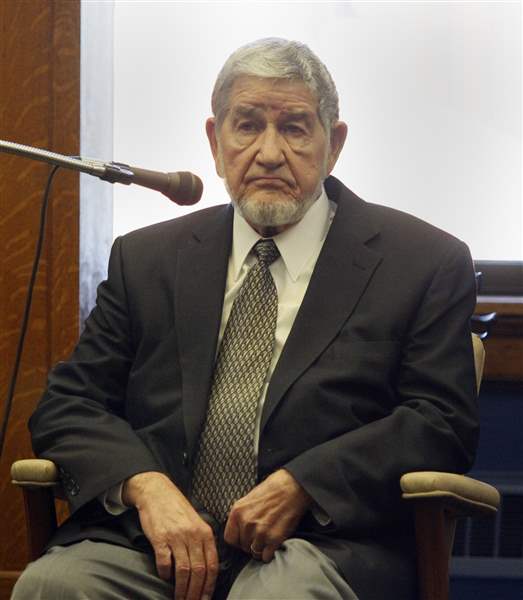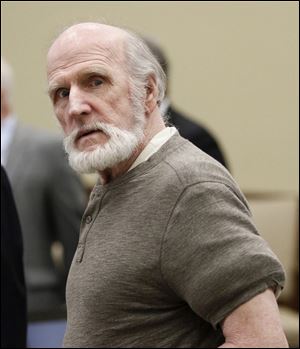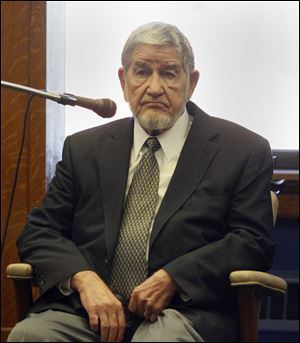
First witness testifies in Bowman retrial
75-year-old charged in 1967 slaying of Sylvania Twp. teenager
10/17/2011
Walter Trowbridge, retired Monroe County Sheriff, testifies in the retrial Monday.
THE BLADE/JETTA FRASER
Buy This Image

Robert Bowman is on trial again for the 1967 slaying of Eileen Adams, a Sylvania Township teenager.
A Lucas County Common Pleas Court jury heard testimony Monday from the first witness to take the stand in the retrial of Robert Bowman.
Bowman, 75, is charged in the slaying of Eileen Adams, a Sylvania Township teenager whose body was found Jan. 30, 1968, after being reported missing 43 days earlier.
Prior to the start of testimony, Judge Gene Zmuda noted for jurors that Bowman’s first trial ended in a mistrial. He then ordered jurors not to consider “for any purpose” that the case had been tried before.
During opening statements, John Weglian, chief of the special units division for the prosecutor’s office, outlined for jurors the case, starting with the disappearance of Miss Adams and the discovery of her body through to Bowman’s arrest more than 40 years later. He noted that authorities had no viable suspects in the case until 1981, when Bowman’s former wife, Margaret, came forward to Toledo police.
He said it was then that police first turned their attention to Bowman. However, it was still years later that DNA provided the physical link between Bowman and Miss Adams’ death, he said.
Mr. Weglian added that the statistical possibility that the DNA, taken from semen fond in the victim’s underwear, was someone other than Bowman was 1 in 4 million.
“If Margaret Bowman made this story up out of spite or a drunken stupor, she had to be the luckiest liar,” Mr. Weglian said. “…But if she was there and the defendant was there and Eileen Adams was there in December, 1967, then her chances of being right were one to one.”

Walter Trowbridge, retired Monroe County Sheriff, testifies in the retrial Monday.
Defense attorney Pete Rost told jurors during opening statements that although 4 million seemed to be a large number, they would hear “much higher numbers when it came to DNA testing.” He also told jurors that the evidence would show that subsequent testing resulted in much lower statistics, including one in 10 and one in four people having the DNA.
Mr. Rost separated Miss Adams’ case into three areas: the time of her disappearance and death, the time Mrs. Bowman came forward, and the reopening of the case in 2006 by cold-case detectives. He noted that from the beginning, the media disseminated “in great detail” facts of the case, which initially resulted in a compiled list of 54 suspects.
“All led to no arrest,” he said.
He told jurors that 14 years later, when Mrs. Bowman came forward, police traveled to Miami where Bowman lived a “hermit lifestyle.”
“Nothing they had at that point would connect Robert Bowman to what they have, either physical evidence or statements,” he said.
Taking the stand first in the case was Miss Adams’ older sister, Mary Ann Brimmer, who testified that she waited for her sister to come over after school on the day of her disappearance. She further testified that Miss Adams’ was wearing a blue skirt and jacket that day.
Also testifying were Miss Adams’ childhood friend, Sandra Jakubec, who said she had taken the bus home from Central Catholic High School with Miss Adams, and former Monroe County Sheriff Walter Trowbridge, who testified that Miss Adams was found in an overgrown area in Whiteford Township with her hands tied in front of her, her ankles tied to a cord that wrapped around her neck, and a nail in the back of her skull.
The three witnesses also testified at Bowman’s first trial, which ended Aug. 23 in a mistrial after a jury of nine women and three men deadlocked and could not reach a consensus.